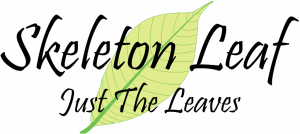So Many Different Uses For Skeleton Leaves
There are so many different uses for skeleton leaves. Perhaps you have some spare leaves and are wondering what to do with them. Well here are some great ideas for you! Please let us know how you get on. And if you like to use your leaves in some way that doesn’t appear here, we’d love to hear about it.
1. Stick on to Paper or Card
A very popular use for skeleton leaves is to stick them on to paper or card to make cards, invitations or gift tags. You can also use them to add some fun to your scrapbooking projects. We generally recommend you use PVA glue, though you can also use other liquid glues or a glue stick. The leaves adhere well to a wide variety of surfaces.
For more interest, cut out a simple shape such as a heart or star from the leaf using a paper punch or a craft knife.
For even more interest still, add some fancy embellishments such as fine glitter, small glass seed beads or even tiny rhinestones or sequins.
2. Use for printing
Print beautiful leaf impressions by using leaves like a rubber stamp. Brush watercolour paint or ink on one side of a leaf, press against the card or paper and then lift gently away.
3. Use to decorate tables
Another of the popular uses for skeleton leaves is to add a special touch to tables during festive occasions such as weddings and Christmas. Arrange your leaves in floral patterns or simply drift them over the table surface. Additionally, why not adorn your napkins by tying a leaf with a ribbon to each napkin?
4. Make hanging garlands
Space leaves out evenly along a length of heavy thread (say about 0.5mm-1.0mm thick) and drape over furniture, mantelpieces, mirrors, paintings etc. Suitable threads such as cotton twine, hemp twine, baker’s twine or natural jute twine are all available from craft suppliers. Attach the leaves using either a glue gun or by threading onto the twine (in which case use a needle to thread the twine through close to the base of each central leaf stem and then tie a knot on either side to keep the leaf in place).
Another possibility is to create a backdrop using several garlands arranged together; suspend the individual garlands vertically, spaced apart at regular intervals.
You can also apply some dabs of glue to the leaves and sprinkle on fine glitter for effect.
5. Decoupage onto glass
Decoupage is a form of art in which a surface is decorated with shapes (in our case, skeleton leaves) and then coated with varnish or lacquer. The surface could be that of a glass votive candle holder, a glass or ceramic vase or a large glass jar. It’s possible to decoupage either the exterior surface or the interior surface as you wish.
Use rubbing alcohol first to clean any grease off the glass surface. Depending on your design, you may want to use masking tape to frame the area you want to work on. Tip: Lay your glass object on a bag of rice or beans so it doesn’t roll around. A glossy decoupage glue such as Mod Podge works best. With a craft paint brush, apply a thin layer of decoupage glue to the back of the leaf, position the leaf where you want it and then press it into place with your fingers. Finally, paint over the top of the leaf and surrounding area with another layer of decoupage glue.
6. Decorate candles
Skeleton leaves can enhance a simple plain candle into something beautiful and unique.
Affixing the leaves requires softening the candle surface just enough so that the leaf starts to sink into the wax.
You will need a cup of very hot water, two large spoons and some grease-proof paper. First put the spoons into the water to warm up. Then position your first leaf on the candle and place some grease-proof paper over it. Apply the back of one hot spoon to the leaf through the grease-proof paper and hold for about 10 seconds. Return the spoon to the hot water and use the other spoon to continue the process. Move onto the next leaf once all the edges are well stuck.
7. Decorate natural branches
Use a glue gun to attach leaves to dried branches such as silver birch, willow, manzanita etc. to form a stunning display.
8. Use in paper making
Skeleton leaves can be incorporated into art papers during the paper making process. In Thailand this can be seen in hand made mulberry papers.
9. Make a Bodhi Leaf Bowl
Click on Make Your Own Bodhi Leaf Bowl to see how to make a beautiful Bodhi leaf bowl. Alternatively, you could apply the same method, using a plastic or cardboard box as the mould, and make a Bodhi leaf box.

